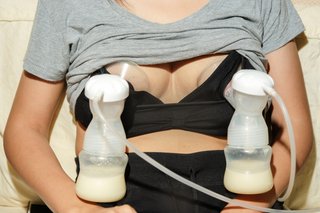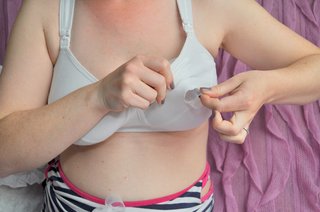Along with hand expressing, you can start to use a double breast pump from the day your baby is born. This helps to stimulate your milk production.
Generally, when your body starts to produce more milk, the yellow colostrum (first milk) changes to more white-coloured breast milk. This happens from around day 3.
Your first breast milk (colostrum)
Getting help to pump
Depending on your and your baby’s situation, you can usually use a hospital-grade double electric pump. Your nurse or midwife will guide you. Electric breast pumps are available in the maternity and neonatal units.
Your nurse or midwife will:
- show you how to use the pump
- give you sterile containers for your milk
- help you to pump beside your baby or in the expressing rooms
The first time you use the breast pump, ask them to check that the:
- fit of the attachment is comfortable for you
- suction of the pump is correct
Continue breast massage and hand expressing a few minutes before and after pumping.
Expressing breast milk for premature babies (video)
How often to pump
Use the pump to express milk at least 8 times in 24 hours. This may seem like a lot but newborn babies feed this often.
It can take about 20 to 30 minutes to massage your breasts and express your milk in the early days.
Do not express for more than 20 minutes at each breast.
Double pumping

You can pump milk from both breasts at the same time. This is called double pumping.
Try double pumping your milk:
- every 2 to 3 hours
- at least once between midnight and 6am
You also need to continue to massage and express often. This helps to establish your milk supply.
The amount of milk you make depends on how often you express.
Managing your milk supply when expressing
Keep an expressing diary
It helps to keep a log of the amount of milk you express.
We have a sample expressing diary in the booklet Breastfeeding and expressing for your premature or sick baby (PDF, 5.6 MB, 48 pages)
Hands-on pumping (HOP)
The best way to establish your milk supply is to combine hand expressing and pumping.
Gently continue to massage and compress your breasts while you express using the double hospital-grade breast pump. This is called hands-on pumping (HOP). It helps drain your breasts more fully. Drained breasts make milk faster.
It also helps to pump from both breasts at the same time.
Pumping both breasts together:
- is quicker
- expresses more milk
The milk expressed using hands-on pumping also has a higher fat content. This is important for ill and premature babies.
When you express milk, there is often a drop in milk supply around week 3. Doing HOP means your milk supply continues to increase gradually. You will usually have full supply by 4 to 6 weeks.
Preparing to pump
- Wash your hands.
- Wipe the pump and tubes with a sterile disposable wipe.
- Wash your hands again.
- Connect the sterilised expressing set to the tubing and the pump.
You will need a comfortable chair with your back supported.
Doing hands-on pumping
High suction pressure can cause nipple damage. It does not help you to get any more milk. If the pressure feels uncomfortable, turn it down and gradually increase as you get used to the sensation.
- Check that the suction pressure is on the minimum or a comfortable setting.
- Support your breast with your hand and place your nipple in the centre of the funnel.
- Hold the funnel so that the pump can maintain a vacuum. Do not press the funnel too firmly into your breast tissue - this can stop the milk flow.
- Turn on the pump. The pressure will be on the minimum setting and on 'stimulating phase' or fast cycle. This continues for 2 minutes and changes to 'expressing phase' or slow cycle.
- Apply gentle pressure on your breasts or gently compress your breasts with your hand.
- If milk does not start to flow during the stimulating phase, you can repeat this phase again. The pump will automatically change to expressing phase after 2 minutes. Do not express for more than 20 minutes.
- When the suction stops, remove the funnel.

Adapting your bra
You can adapt your bra for pumping by cutting a small hole in each cup. This makes it easier to place the pump funnels and attach them to the bottles. It also helps when you do hands-on pumping.


Dealing with sore breasts or nipples
Expressing milk should not hurt.
There are things you can do if your nipples are sore while you use the breast pump.
Do
-
tell your midwife or the nurse caring for your baby that your nipples are sore
-
try using a nipple balm or cream to ease any tenderness
-
rub some of your breast milk on your nipple
-
check the size of the funnel on the breast pump - you may need a different size
-
reduce the suction pressure on the pump if you feel the pressure is too high for you
-
turn off the suction pressure before you remove the funnel from your breast
Signs that expressing is going well
Signs that expressing is going well include:
- expressing at least 8 times in 24 hours - this includes at least once between midnight and 6am
- no gaps between expressing that are longer than 4 hours during the day and 6 hours at night
- being able to stimulate milk production using breast massage, relaxation, skin-to-skin contact or being close to your baby
- good milk flow
- your breasts feeling softer after expressing milk
- your milk supply gradually increasing to meet your baby’s needs
- no red areas on your breasts or nipple damage
- confident hand expressing, using a breast pump, double pumping and hands-on pumping (HOP)
- being aware of power pumping, if you're struggling with low milk supply
Cleaning and sterilising expressing sets
Your midwife or nurse will:
- give you information and guidelines on cleaning and sterilising breast pump equipment
- tell you how to store your milk
There may be a place in the hospital unit for you to clean and sterilise your equipment. Some units provide sterilised disposable kits. You may need to return the used kits for sterilisation.
Ask the hospital staff for help and information about breast pump equipment.
Pumping at home
You will need a hospital-grade electric pump at home.
The staff in the maternity or neonatal unit can give you information about sourcing a hospital grade electric pump in your area. Your partner or support person could do this for you.
You may be able to claim tax relief on the cost of breast pumps you rent or buy.
